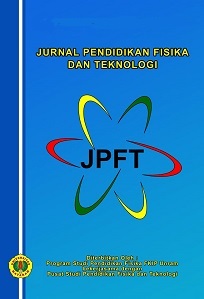Seismic Vulnerability Index Mapping Based on PGA, GSS, and MMI Values in Pasar Ujung Kepahiang Village
DOI:
10.29303/jpft.v10i2.7440Published:
2024-11-20Issue:
Vol. 10 No. 2 (2024): July - DecemberKeywords:
Microtremors, IKS, PGA, GSS, MMIArticles
Downloads
How to Cite
Downloads
Metrics
Abstract
Pasar Ujung Village is located in Kepahiang District, which has the highest growth rate and population compared to other sub-districts in Kepahiang Regency, with a growth rate of 1.63% and a population of 53,066 thousand people. As one of the efforts to minimize the occurrence of damage due to earthquake disasters in Pasar Ujung Village, Kepahiang, it is necessary to map the seismic vulnerability index using the microtremor method. The research was conducted in Pasar Ujung Village, Kepahiang. Measurement points were placed at 28 points with a distance of approximately 200 m between points. Primary data used in this study came from microtremor surveys with A0 and f0 values. The results of the study are also included in the high-risk category for the social impact of earthquake disasters with an MMI value of more than 7. Based on the PGA map, it shows that the research location is quite prone to damage due to earthquakes, with a PGA value of > 564gal. Based on the PGA value obtained, the value is classified as instrumental intensity scale VI-VIII with shaking strength in the strong to very strong category. The magnitude of the earthquake, the depth of the source, and the distance of the earthquake source from the research location also contribute. The thickness of the surface sediment layer can be a consideration for people who will carry out development.
References
Al Ansory, A. R., Raihana, H., Farid, M., & Hadi, A. I. (2024). Investigation of Sediment Layer Thickness Estimation at Bengkulu University Hospital Based on A0, f0, and T0 Values. Jurnal Geocelebes, 8(1), 1–10. https://doi.org/10.20956/geocelebes.v8i1.28144
Ardiansyah, S., Geofisika Kepahiang-Bengkulu, S., Pembangunan, J., 156 Pasar, N., & Kepahiang-Bengkulu, U. (1997). Energi Potensial Gempabumi Di Kawasan Segmen Musi, Kepahiang-Bengkulu Earthquake Potential Energy in the Musi Segment, Kepahiang-Bengkulu Area.
BMKG. (2017). Badan meteorologi klimatologi dan geofisika. 12(2), 2010–2011.
BPS Kepahiang. (2024). Kepahiang Dalam Angka 2024. 4(1), 9–15.
Edwiza. (2008). Analisis Terhadap Intensitas Dan Percepatan Tanah Maksimum Gempa Sumbar. TeknikA, 1(29), 73–79.
Fitri, D. A. (2018). Pemetaan zonasi indeks kerentanan seismik pada daerah pasca tambang di PT. Bukit Asam Persero TBK. unit penambangan ombilin, sawah lunto. 1–26.
Hadi, A. I., Farid, M., & Fauzi, Y. (2012). Pemetaan Percepatan Getaran Tanah Maksimum dan Kerentanan Seismik Akibat Gempa Bumi untuk Mendukung Rencana Tata Ruang dan Wilayah (RTRW) Kota Bengkulu. SIMETRI, Jurnal Ilmu Fisika Indonesia, 1(2D), 81–86.
Hadi, A. I., Refrizon, R., Halauddin, H., Lidiawati, L., & Edo, P. (2021). Interpretasi Tingkat Kekerasan Batuan Bawah Permukaan di Daerah Rawan Gempa Bumi Kota Bengkulu. Indonesian Journal of Applied Physics, 11(1), 11. https://doi.org/10.13057/ijap.v11i1.46525
Lunga, S. (2016). Penentuan Dan Pemetaan Nilai Percepatan Tanah Maksimum, Indeks Kerentanan Seismik Dan Ground Shear Strain Di Wilayah Kota Jayapura Berdasarkan Pengukuran Mikrotremor. 1–140.
Nakamura, Y. (2000). Clear identification of fundamental idea of Nakamura’s technique and its applications. Proceedings of the 12th World Conference on …, Paper no. 2656. http://www.sdr.co.jp/papers/n_tech_and_application.pdf
Nakamura, Y. (2008). On the H/V spectrum. The 14th World Conference on Earthquake Engineering, 1–10. http://117.120.50.114/papers/14wcee/14wcee_hv.pdf
Putri, A., Purwanto, M. S., & Widodo, A. (2017). I Jalur Sesar Kendeng. Geosaintek, 03(2), 107–114.
Saaduddin, Sismanto, & Marjiyono. (2015). Pemetaan Indeks Kerentanan Seismik Kota Padang Sumatera Barat Dan Korelasinya Dengan Titik Kerusakan Gempabumi 30. Seminar Nasional Kebumian Ke-8, October, 459–466.
Sihombing, R. B., & Rustadi, R. (2020). Pemodelan Dan Analisa Struktur Bawah Permukaan Daerah Prospek Panasbumi Kepahiang Berdasarkan Metode Gayaberat. JGE (Jurnal Geofisika Eksplorasi), 4(2), 159–172. https://doi.org/10.23960/jge.v4i2.14
Sugianto, N., Frid, M., & Suhendra. (2017). Kondisi Geologi Lokal Kota Bengkulu. Jurnal Fisika Dan Aplikasinya, 2(April), 29–36.
Yulita, T., Lubis, C. T., & Hidayat, A. S. E. (2023). Penentuan Premi Murni Di Kabupaten Kepahiang Provinsi Bengkulu Dengan Memperhitungkan Peluang Kejadian Gempa Bumi Dan Rasio Kerusakan Bangunan. VARIANCE: Journal of Statistics and Its Applications, 5(2), 147–158. https://doi.org/10.30598/variancevol5iss2page147-158
Author Biographies
Destika Meisy Sapanur, University of Bengkulu
Physics Department
Arif ismul Hadi, University of Bengkulu
Physics Department
Refrizon Refrizon, University of Bengkulu
Physics Department
License
Copyright (c) 2024 Arif ismul Hadi, Refrizon Refrizon, Destika Meisy Sapanur

This work is licensed under a Creative Commons Attribution-ShareAlike 4.0 International License.
Authors who publish with Jurnal Pendidikan Fisika dan Teknologi (JPFT) agree to the following terms:
- Authors retain copyright and grant the journal right of first publication with the work simultaneously licensed under a Creative Commons Attribution License 4.0 International License (CC-BY-SA License). This license allows authors to use all articles, data sets, graphics, and appendices in data mining applications, search engines, web sites, blogs, and other platforms by providing an appropriate reference. The journal allows the author(s) to hold the copyright without restrictions and will retain publishing rights without restrictions.
- Authors are able to enter into separate, additional contractual arrangements for the non-exclusive distribution of the journal's published version of the work (e.g., post it to an institutional repository or publish it in a book), with an acknowledgement of its initial publication in Jurnal Pendidikan Fisika dan Teknologi (JPFT).
- Authors are permitted and encouraged to post their work online (e.g., in institutional repositories or on their website) prior to and during the submission process, as it can lead to productive exchanges, as well as earlier and greater citation of published work (See The Effect of Open Access).











